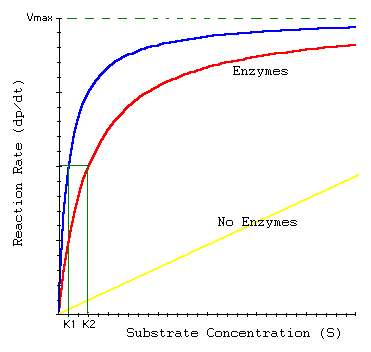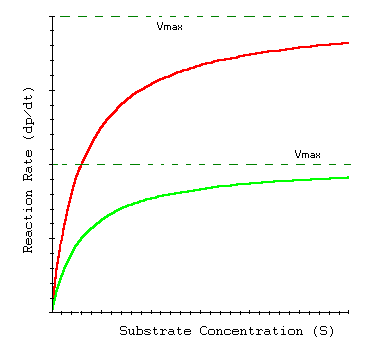
ENZYMES AND THE RATE OF CHEMICAL REACTIONS
Introduction: Enzymes are proteins that speed up the rate of a chemical reaction without being used up. Enzymes are usually specific to particular substrates. The substrates in the reaction bind to active sites on the surface of the enzyme. The enzyme-substrate complex then undergoes a reaction to form a product along with the original enzyme.
Importance: The rate of a chemical reaction is affected by the total number of enzymes as well as the concentration of substrates. We can describe the reaction rate with a simple equation to understand how enzymes affect chemical reactions.
Question: How do enzymes and substrate concentration affect the rate of a chemical reaction?
Variables:
|
dp/dt |
the rate of product formation (mol/cm3/sec) |
|
k |
linear constant (1/sec) |
|
Vmax |
the maximum reaction rate (mol/cm3/sec) |
|
S |
the substrate concentration (mol/cm3) |
|
E |
the enzyme concentration (mol/cm3) |
|
K |
Michaelis-Menten constant (mol/cm3) |
|
kcat |
the catalytic constant (1/sec) |
Methods: In the absence of enzymes, the rate of a reaction can be thought to increase linearly with substrate concentration. The reaction rate is given as dp/dt, or the change in product over time:

where S is the substrate concentration, and k is the frequency at which substrate is converted to product.
The rate of a reaction involving enzymes also increases as the substrate concentration increases. However, the number of enzyme active sites available is limited. At low enzyme concentrations or high substrate concentrations, all of the available enzyme active sites could be occupied with substrates. Therefore, increasing the substrate concentration further will not change the rate of diffusion. In other words, there is some maximum reaction rate (Vmax) when all enzyme active sites are occupied. The reaction rate will increase with increasing substrate concentration, but must asymptotically approach the saturation rate, Vmax. Vmax is directly proportional to the total enzyme concentration, E, and the cata lytic constant of the enzyme, kcat, which describes the frequency at which the enzyme-substrate complex is converted to product. How quickly enzyme active sites become saturated can be described by the variable K, the substrate concentration at which the reaction rate is Vmax. K is called the Michaelis-Menten constant after the scientists who originally derived it. The reaction rate can be described by the equation

where S is the substrate concentration.
We can graph dp/dt as a function of S to see how the reaction rate changes with increasing substrate concentration for reactions in the presence and absence of enzymes.

Interpretation: As we can see, the rate of product formation increases with increasing substrate concentration. However, in the presence of enzymes the function dp/dt has higher values and a much steeper slope. This implies enzymes greatly increase the reaction rate. However, as the enzymes become saturated, the reaction rate levels off.
By plotting dp/dt as a function of S for two different values of K (red and blue lines), we can see how the Michaelis-Menten constant affects the reaction. When K is small (blue line with value K1) the reaction approaches Vmax much more quickly.
Now we will hold K constant and plot dp/dt as a function of S for different values of E.

When the enzyme concentration is small, Vmax is much smaller. The reaction rate still increases with increasing substrate concentration, but levels off at a much lower rate. By increasing the enzyme concentration, the maximum reaction rate greatly increases.
Conclusions: The rate of a chemical reaction increases as the substrate concentration increases. Enzymes can greatly speed up the rate of a reaction. However, enzymes become saturated when the substrate concentration is high. Additionally, the reaction rate depends on properties of the enzyme (K, kcat) and the enzyme concentration (E).
Additional Questions:
1. What kind of function is dp/dt as a function of E? Graph this function and interpret the graph. What properties affect the slope of this equation?
Sources: Michaelis, L. and M. L. Menten. 1913. Die kinetik der invertinwirkung. Biochem. Z. 49:333-369.
Segel, L. A. 1984. Modeling dynamic phenomena in molecular and cellular biology. Cambridge University Press, NY
Darnell, J., J. Lodish, and D. Baltimore. 1986. Molecular cell biology. Scientific American Books, NY
Copyright 1999 M. Beals, L. Gross, S. Harrell